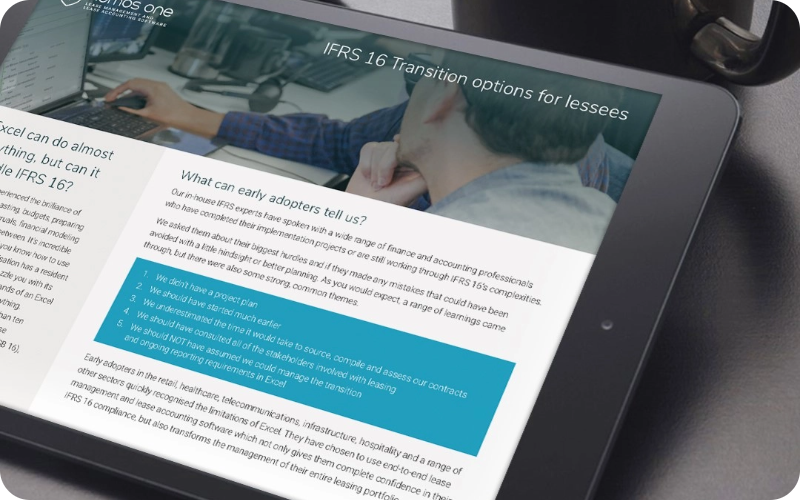For organisations managing a lease portfolio, whether it consists of ten leases or several hundred, a mid-year review presents a valuable opportunity to assess performance, identify potential risks, and ensure that the lease data and accounting treatments are aligned with internal controls and external reporting obligations. Too often, lease management becomes reactive. But with regulations such as IFRS 16 (AASB 16) requiring precision in lease accounting, a proactive and thorough mid-year portfolio review is essential to avoid costly errors and ensure operational readiness for the second half of the (financial) year. Below, we outline the critical elements that should be part of your mid-year lease review process, providing practical guidance for property, finance, and compliance teams alike.

Lease data accuracy
The accuracy of your lease data underpins every aspect of financial reporting and operational decision-making. A mid-year review should begin with a detailed examination of the core data held for each lease. This includes verifying that the start and end dates of each agreement are correct, ensuring the lease terms align with the original (or most recently amended) contracts, and confirming that any options for renewal, rent-free periods, or early termination clauses have been properly documented. It is also important to review the classification of each lease to ensure it reflects the appropriate accounting treatment. Misclassified leases can distort balance sheet and profit-and-loss statements, affecting not only compliance but also financial planning. Cross-referencing lease records with signed agreements and variations helps to validate the integrity of the data and creates confidence in your year-to-date reporting.
Event monitoring
Lease events, such as rent reviews, renewal deadlines, and expiry dates, are pivotal points in a lease’s lifecycle that often require timely decisions or actions. A common risk in lease management is failing to act on these events early enough, which can lead to automatic renewals on unfavourable terms, missed negotiation windows, or unforeseen financial liabilities. The mid-year review should include a thorough review of all upcoming events over the next six to twelve months. This includes both financial events, such as scheduled rent increases or CPI adjustments, and operational milestones, such as maintenance requirements, make-good obligations, or lease expiries. If your organisation uses dedicated lease management software, such as Nomos One, this process becomes significantly easier. Upcoming events are clearly listed, and reminder notifications ensure that critical deadlines are not missed. Proactively reviewing these events allows teams to allocate responsibilities, consult stakeholders, and prepare well in advance.
Journal entries and remeasurements
Lease accounting under IFRS 16 and its equivalents requires a continuous process of recognising lease liabilities, adjusting for changes, and accurately reflecting lease expenses in the general ledger. A mid-year review is a critical time to ensure that all financial entries are aligned with the lease data and that any changes throughout the year have been correctly captured. This includes checking that all scheduled rent increases and CPI adjustments have been reflected in the system and reconciled against actual payments. Remeasurements, whether triggered by changes in lease term or modifications to contractual payments, must be properly documented and booked into the accounting system. Organisations should also take this opportunity to validate the amortisation of the right-of-use assets and lease liabilities, ensuring that balances reconcile with the year-to-date journals. Software solutions like Nomos One provide audit-ready reports and automate journal calculations, significantly reducing the administrative burden of mid-year financial checks.

Access and permissions
As lease portfolios and teams grow, maintaining proper access controls becomes increasingly important. The mid-year review is an excellent time to audit user access within your lease management system. Reviewing who has access, what roles they hold, and whether their permissions align with current responsibilities is critical for maintaining security and minimising risk. Former employees or team members who have shifted roles should have their access revoked or adjusted. Equally, finance-only data and sensitive documents should be accessible only to users with the appropriate level of authorisation. Making sure that the system’s user management framework reflects the current structure of your organisation is an important part of safeguarding your lease data and enforcing internal governance standards.
Supporting year-end audit and reporting
In regulated environments, maintaining accurate, accessible lease documentation is not optional - it is a necessity. A mid-year check-in provides the opportunity to assess whether your current lease records are complete, well-organised, and audit-ready. This includes ensuring that all relevant documents, such as signed lease agreements, amendments, communications, and legal correspondence, are stored in a centralised, accessible location. You should also confirm that any leases added or terminated during the first half of the year have been correctly recorded and reflected in your accounting entries. Staying informed about any changes to lease accounting standards is also part of this process. If your jurisdiction has issued updates or new guidance, your policies and processes may need to be reviewed and updated accordingly.
Workflow consistency
One of the often-overlooked strengths of lease management software is its ability to guide users through consistent, repeatable processes for managing events. Whether it’s a rent review, renewal, or termination, workflows ensure that each step - from internal notification to contractual updates - is captured and logged accurately. During your review, evaluate whether your existing workflows remain aligned with operational needs. Are users following the structured processes provided? Are lease changes and approvals being documented consistently? Are audit trails being maintained as intended? Nomos One supports this through intuitive event workflows that reduce manual entry and ensure every relevant change is recorded against the appropriate lease. These workflows not only promote accuracy and efficiency but also strengthen accountability and audit readiness.

Gaining strategic visibility
Beyond compliance and accuracy, the mid-year review should also provide a strategic lens on your lease portfolio. With real-time data and reporting capabilities, you can assess whether the portfolio is supporting or hindering broader organisational goals.
Reviewing space utilisation, cost trends, and lease end dates may highlight opportunities for consolidation, renegotiation, or expansion. Aggregated dashboards, such as those offered by Nomos One, allow for a high-level view of lease performance, helping your team make proactive decisions around future leasing strategy. Visibility across the portfolio also supports better coordination among departments, helping ensure that finance, legal, facilities, and operations are aligned and working from a single source of truth.
A mid-year lease portfolio review is more than an administrative task. It is a strategic exercise that safeguards financial accuracy, strengthens compliance, and positions the organisation to act decisively on opportunities and obligations in the months ahead. With the help of purpose-built lease management platforms like Nomos One, this review process can be transformed from a time-consuming manual task into a streamlined, automated workflow, one that empowers teams to manage leases with greater control, accuracy, and confidence.
Learn how Nomos One can help you seamlessly and securely automate, track, and manage lease obligations across your portfolio - book a demo with our team today.

























